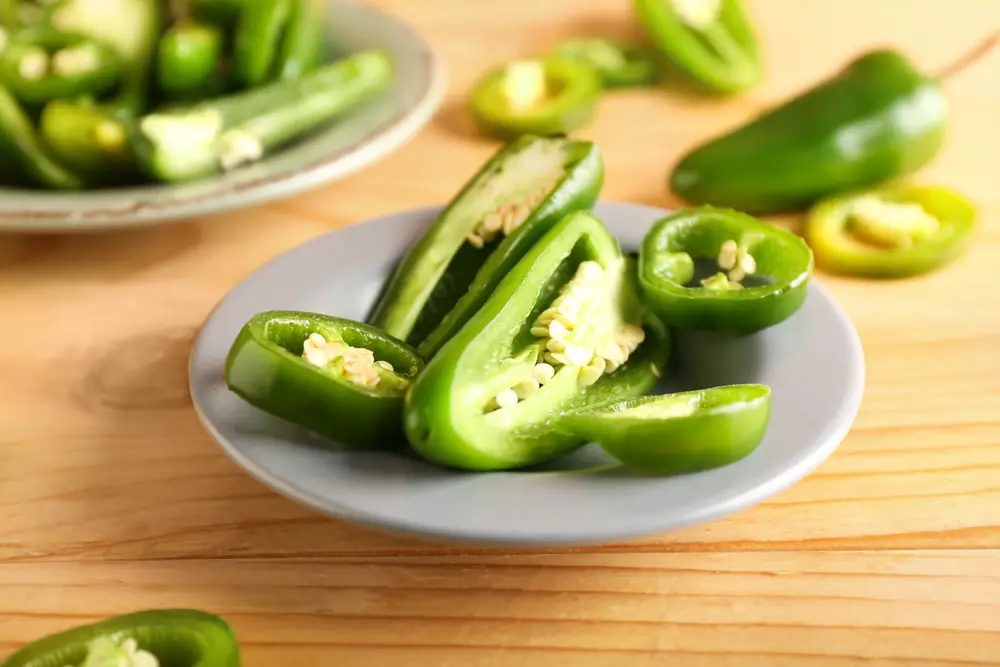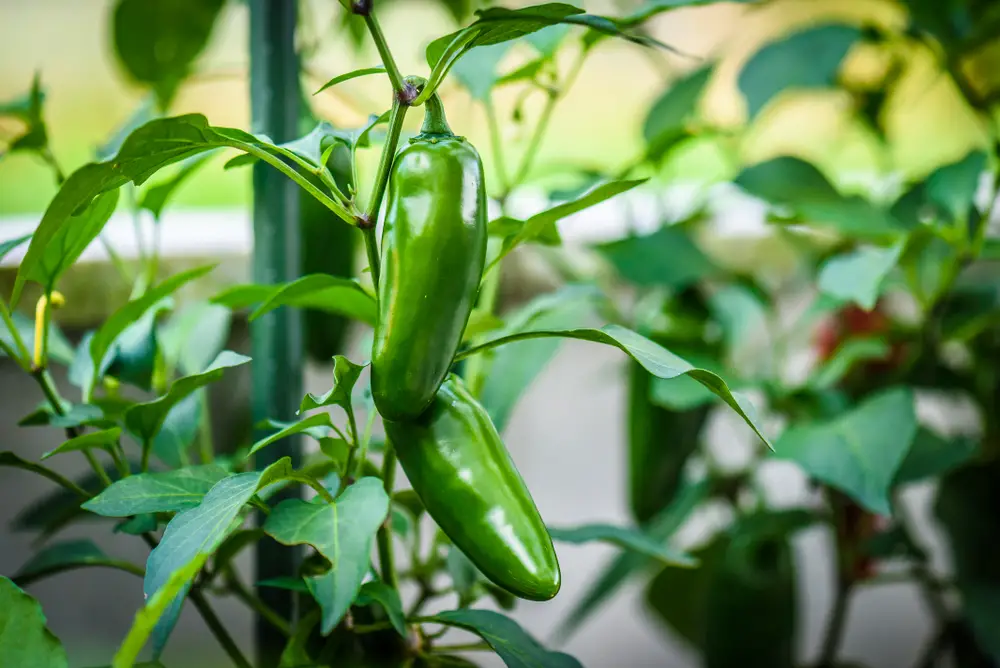Many individuals don’t check whether the food they’re eating is a fruit or a vegetable.
After all, it’s common knowledge that anything sweet is fruit and something not sweet is a vegetable. But perhaps we should inform you that this rule has some exceptions.
The Jalapeno Pepper is not a vegetable. It’s considered to be a fruit and is categorised as a berry. Other chillies like chili peppers, serrano’s, and poblanos are all classified as fruits. Other chilies, such as chili peppers, serranoes, and poblanos, are all classified as fruits.
Is Jalapeno a Vegetable or a Fruit?
Jalapeno Chili is a fruit, yet most people believe that because chilies aren’t sweet, they belong in the vegetable category.
Some of us also thought that Jalapeno peppers were veggies. It was a misperception since it isn’t true because Jalapeno is a fruit.
But why does something that isn’t as plump as a banana or as juicy and acidic as an orange fall under the category of fruit?
So, Are Peppers Fruits or a Vegetables?
It all depends on the circumstances. A botanist can use the botanical taxonomy to learn about the origins of peppers, find different variations of peppers, and understand how to grow and harvest different species of peppers.
Yet, how many of us, are botanists?
The culinary definition may be more relevant for your everyday customer because the foods that are from the same botanical family, may not have the same nutritional contents.
Is there an exemption in the case of Jalapeno peppers? Is Jalapeno a fruit or a vegetable? The strong flavor of the Jalapeno leads most people to believe it is a vegetable.
However, this is not the case. Jalapeno is a fruit, according to botanical classification. Yes, you read that correctly!! The Jalapeno is a type of fruit.
The Jalapeno pepper, in particular, is classified as a berry. Berry is a fleshy fruit with many seeds within, according to botanists. As a result, Jalapenos – along with their seeds inside are also classified as berries.
In fact, all types of peppers and bell peppers with edible seeds are fruits rather than vegetables.
Many fruits, such as eggplant, tomato, zucchini, cucumber, and beans, are considered vegetables. They’re all members of the fruit family.
What’s the Difference Between Fruit and Vegetable?
While it’s typically simple to tell the difference between fruits and vegetables, have you ever paused to consider the differences?
Fruits and vegetables are classified botanically and gastronomically.
Botanically, fruits and vegetables are classified according to the part of the plant from which they originate. While some fruit comes from a plant’s blossom, veggies sprout from different parts of the plant.
Another significant distinction is that fruits have seeds, but vegetables might have roots, stems, and leaves.
Fruits and vegetables are categorized depending on their flavor in the culinary world. Fruits can be used in desserts, snacks, and liquids and have a sweet or tart flavor. This isn’t always the case, though. Tomatoes are another example of a non-sweet fruit, aside from peppers, which are hot fruits.
Why Is a Jalapeno Considered a Fruit?
Although it may seem strange that a Jalapeno is a fruit, you’ll be even more astonished to learn that tomatoes, eggplant, zucchini, and okra are all fruits. What do they have in common? All of them contain edible seeds within.
Except for some vegetables, which have seeds, veggies are the seedless consumable sections of the plants. To answer your question, seeds, not flavor, decide whether something is a fruit or a vegetable.
What Exactly Is a Jalapeno?
The Jalapeno pepper is a medium-sized pod-type chili pepper cultivar from the capsicum family.
A native to Mexico This mildly hot chili pepper is widely consumed around the world.
It gets its name from the Mexican city of “Jalapa,” where it was first grown.
It hangs down from the plant and reaches a length of 2-4 inches, with 1 to 2 inches of thick, spherical, and firm meat. It starts green, but as it ripens, it turns red, orange, or yellow.
It can be eaten raw or used as a spice in a variety of dishes. You can get canned sliced or pickled Jalapeno in the store aisles.
Jalapeno’s Health Benefits

- The raw Jalapeno contains 92 percent water and has no fat, making it an excellent supplement to any diet.
- Apart from that, jalapenos are high in vitamin C, somewhat high in vitamin K, vitamin A, vitamin E, and vitamin B6. Some of the health benefits of jalapenos are listed below.
- Jalapenos aid in the reduction of blood pressure. Other chilies, not just Jalapeno, have been discovered to reduce blood pressure, according to this study!
- Including jalapenos in your diet can help you lose weight by suppressing your appetite and increasing your metabolism. This claim is supported by a study released by NCBI.
- Capsaicin, a compound found in jalapenos and other chili peppers, has anti-cancer potential. More human research is needed to back up this claim.
- Contrary to popular belief, capsaicin can lessen stomach inflammation, but this is not true for other spicy foods.
- According to this study, eating Jalapeno can help avoid stomach ulcers. Another study that backs up this assertion may be found here!
- When food is allowed to sit at room temperature for an extended period, common foodborne bacteria and fungus grow at a faster rate.
- By using Jalapeno as a spice in your diet, you can slow down the growth of these food poisoning bacteria and fungi. Chilies contain compounds that can even prevent cholera, a severe foodborne disease caused by bacteria.
Are Peppers Considered Fruits? or Are They Vegetables?
The answer depends upon whom you ask.
Peppers are unmistakably fruits, according to any botanist. In reality, every type of pepper, from ghost to Jalapeno to serrano to habanero, qualifies as a fruit rather than a vegetable.
But why does this strike you as odd? Why isn’t it clear that peppers, like apples, bananas, and oranges, are fruits?
Peppers, after all, don’t taste or look like any of the other berries. Not to forget that, unlike most other fruits, many of them are spicy rather than sweet.
Plus, they don’t seem to mix well with other fruits. Could you imagine a fruit salad with a dash of chili pepper in it?
While botanists might categorize peppers as fruits, chefs may have a different viewpoint. Peppers are, in fact, vegetables, according to the culinary classification.
Peppers are Classified as Fruits by Botanists
When classifying plants, botanists use botanical categorization, which would be based on physiological characteristics of the plant such as structure, function, and organizational organization.
Plants use fruits to disperse their seeds. A fruit is defined as a seed-bearing object that develops from the ovaries of a blooming plant. To put it another way, a fruit is a flowering plant’s method of disseminating its seeds.
Typically, botanical fruits are composed of at least one seed and are produced by a flowering plant. Pepper is considered as fruit under this classification since they contain microscopic seeds in the middle and grow from the pepper plant’s blossom.
In botanical terms, however, a vegetable does not have a specific definition, but rather is a broad phrase that encompasses all other edible components of the plant, such as the roots, stems, and leaves.
So, putting on our botany hats, we’d identify fruits like apples, strawberries, and cherries, as well as peppers, as fruits!
Peppers are Classified as Vegetables in the Culinary World
A nutritionist, chef, or even your grandmother would use the culinary categorization system, which classifies fruits and vegetables differently depending on how they are used and their flavor qualities.
A ‘vegetable,’ in culinary terms, has a rougher texture, a blander flavor, and frequently requires cooking in dishes such as stews, soups, and stir-fries. A ‘fruit,’ on the other hand, has a soft feel, is sweet or tangy, and is commonly eaten raw or in sweets or jams.
Peppers are crisp, refreshing, and delicious when eaten raw. Peppers are widely used in savory dishes such as stews and fajitas, which is why they are typically categorized as vegetables in cookbooks.
What Is A Pepper, Exactly?
Before we get into why peppers are classified the way they are, let’s take a look at what they are.
The Piperaceae family, which includes peppers, contains over 3,600 species in five genera. The two most common genera of peppers are Piper (2,171 species) and Peperomia (2,171 species) (1,373 species).
Although its members in the family contain many other spices, the most well-known species, Piper nigrum, produces the majority of peppercorns used as spices, including the ever-reliable black pepper.
The other genus, Peperomia, is notable for producing chili peppers, which are native to Mexico. Many cuisines use this spice to add heat to their foods.
Capsaicin and related compounds are known as capsaicinoids are the components that give chili peppers their heat when eaten or applied topically.
Many cultivars of chili pepper spread over the world after the Columbian Exchange, and they are now used for both food and traditional medicine.
This variability has resulted in a vast range of cultivars and variations.
Final Thoughts if Jalapeno and Other Peppers Are Fruit or Vegetables.
So, know you know what these peppers really are and what to call them. We really enjoy eating all the different varieties of fruits and we also love our veggies.
Now we’ve completed the ‘reveal’ on the Jalapeno and other Peppers does it make any difference to how they taste? – No! and it shouldn’t!
We shall continue to eat and relish them because as Shakespeare observed “A rose by any other name would smell as sweet” or in this case, we say “a pepper by any other classification would taste as spicy and hot”.
Jenny Marie
Tribal Writer
Edited By
Patricia Godwin

